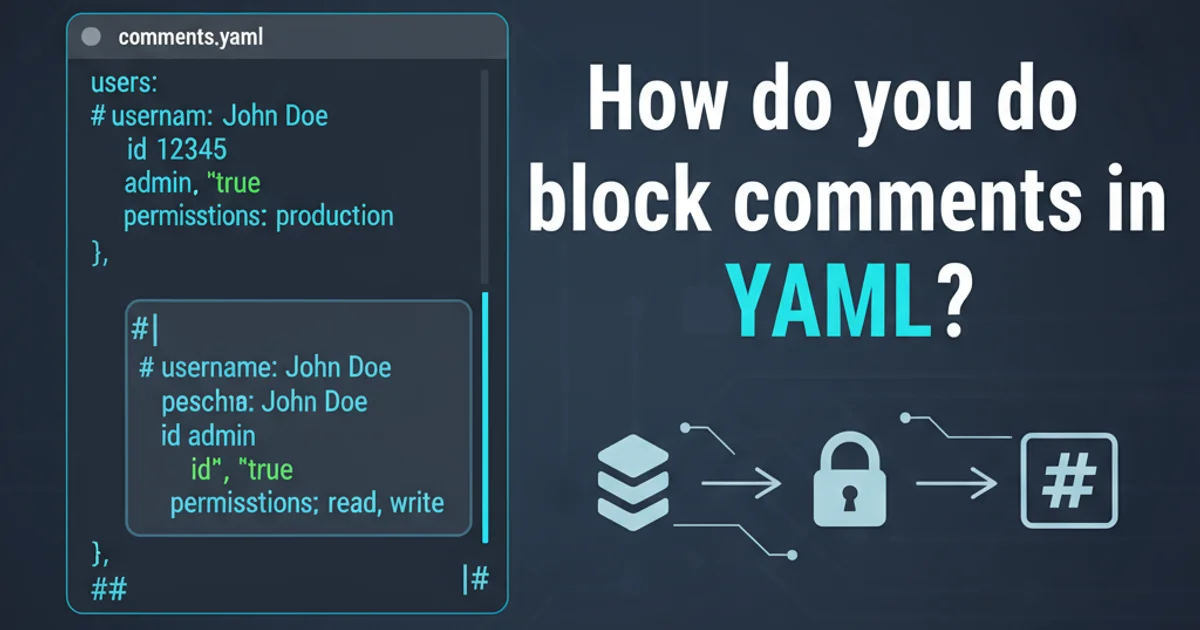How do you do block comments in YAML?
Categories:
Mastering Block Comments in YAML: Techniques and Best Practices

Explore various methods for adding block comments in YAML files, understand their limitations, and learn best practices for effective documentation.
YAML (YAML Ain't Markup Language) is a human-friendly data serialization standard often used for configuration files. While it's excellent for readability, its approach to comments can sometimes be a point of confusion, especially for those accustomed to multi-line block comments in other languages. This article will clarify how to effectively add comments in YAML, focusing on techniques that simulate block comments, and provide best practices for maintaining clear and well-documented YAML configurations.
The Nature of Comments in YAML
Unlike many programming languages that offer distinct syntax for single-line and multi-line (block) comments, YAML only supports a single comment style: the hash symbol (#). Any text following a hash symbol on a given line is considered a comment and is ignored by YAML parsers. This means there is no native multi-line comment syntax in YAML that allows you to wrap a block of text with special delimiters.
# This is a single-line comment
key: value # This is an inline comment
# Another single-line comment
# followed by another one.
list_item:
- item1
- item2
Basic single-line and inline comments in YAML
Simulating Block Comments
Since YAML lacks a dedicated block comment syntax, the most common and universally accepted method to create a 'block' of comments is to prefix each line of the desired comment block with a hash symbol (#). This approach, while manual, ensures compatibility across all YAML parsers and maintains the human-readable nature of YAML.
# This is the start of a simulated block comment.
# It spans multiple lines, with each line
# prefixed by a hash symbol.
# This section describes the database connection settings.
database:
host: localhost
port: 5432
user: admin
Simulating a block comment by prefixing each line with '#'
flowchart TD
A[Start YAML Parsing] --> B{Encounter '#' character?}
B -- Yes --> C[Ignore rest of line]
B -- No --> D[Parse as data]
C --> E[Move to next line]
D --> E
E --> F{End of file?}
F -- No --> B
F -- Yes --> G[End Parsing]How YAML parsers handle comments
Alternative: Commenting Out Blocks of Data
Sometimes, you might want to temporarily disable a section of your YAML configuration without deleting it. This can also be achieved by commenting out each line of the data block. This is particularly useful during development or debugging.
active_feature: true
# --- Temporarily disabled feature ---
# old_feature:
# setting1: value1
# setting2: value2
# sub_settings:
# - item_a
# - item_b
# -----------------------------------
new_feature:
enabled: true
Commenting out a block of data for temporary disabling
Ctrl+/ or Cmd+/) to quickly add or remove the hash symbols.Best Practices for YAML Comments
While the # symbol is straightforward, consistent application of comments improves maintainability. Here are some best practices:
1. Be Clear and Concise
Comments should explain why something is configured a certain way, not just what it is. The YAML structure itself often explains the 'what'.
2. Maintain Indentation
When commenting out a block of data, ensure that the hash symbols are placed at the correct indentation level relative to the original content. This helps preserve readability if you decide to uncomment it later.
3. Separate Comments from Data
For multi-line comments, it's often clearer to place them on their own lines above the relevant data, rather than trying to fit long explanations as inline comments.
4. Use Blank Lines for Readability
Just like in code, blank lines can help break up large blocks of comments or data, improving overall readability.
5. Avoid Over-Commenting
If your YAML is self-explanatory, excessive comments can become clutter. Strive for a balance between clarity and conciseness.